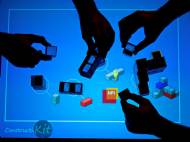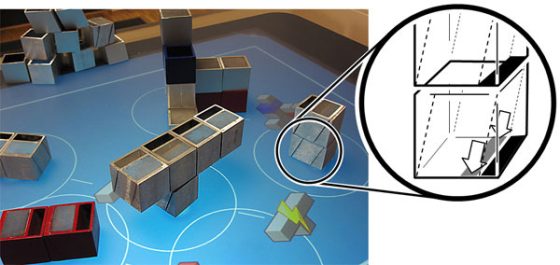Lumino Project – stackable markers for Microsoft Surface
 Tabletop computers based on diffuse illumination can track markers placed on the table’s surface. We demonstrate how to do the same with objects arranged in a three-dimensional structure without modifying the table. We already wrote about tabletop interfaces, as well as the interface with multiple sources of information able to operate in 3D, but this is the first time we’ve seen a Microsoft Surface combined with a marker that enables the recognition of an object’s third dimension.
Tabletop computers based on diffuse illumination can track markers placed on the table’s surface. We demonstrate how to do the same with objects arranged in a three-dimensional structure without modifying the table. We already wrote about tabletop interfaces, as well as the interface with multiple sources of information able to operate in 3D, but this is the first time we’ve seen a Microsoft Surface combined with a marker that enables the recognition of an object’s third dimension.
The Lumino project is being developed by Patrick Baudisch, Torsten Becker and Frederik Rudeck at the Hasso Plattner Institute at the University of Potsdam, Germany. In addition to a marker, each block contains a glass fiber bundle. The bundle optically guides the light reflected off markers in the higher levels down to the table surface, where the table’s built-in camera reads it. While guiding marker images down, the bundle optically scales and rearranges them. It thereby fits the images of an entire vertical arrangement of markers into the horizontal space usually occupied by a single 2D marker.
As blocks stack up, the risk increases that the patterns from different layers of Lumino blocks will become too jumbled for the screen to interpret. However, the fiber-optic bundles are angled so that the pattern visible to the screen at the bottom of a stack includes parts of the patterns of all its blocks. That can allow the screen to recognize stacks up to 10 blocks high.
They have developed three classes of blocks and matching marker designs, each of which is optimized for different requirements and usage. The Lumino blocks can be stacked, and the Surface will behave differently to two stacked blocks. Aside from the obvious checkers implications (it can recognize when players are “kinged”), it could be used as control knobs for tasks like photo editing or building blocks of a construction kit.
The presented blocks do not require any power and are maintenance-free, making them easy to be produced and used in large numbers. The research behind this project could have major implications if tabletop computing and touch screen device become more widely spread. It is only up to developers to enable all kinds of different gestures and interactions Lumino project could offer.










Leave your response!